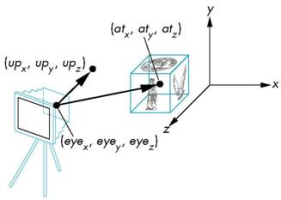Viewing
- Number 1: OpenGL is a dimensionless system.
- A coordinate system exists, however no units have been assigned to that system.
- It is up to us to do so.
- Number 2: OpenGL is a very flexible viewing system
- There is no single camera, lens, ... or other restriction.
- In the end, we need to map a 3d image to a 2d surface.
- Or with current technology, to two different 2d surfaces, drawn from a slightly different position, delivered to each eye.
- The red book describes the viewing process in 5 steps.
- Position the camera to the location from which you wish to shoot your picture.
- Move the jusbject to be photographed into the desired location.
- Pick a lens for the camera and adjust the lens.
- Take the picture
- Shrink or stretch the resulting image to fill your photo paper
- Step 1 is seting up the viewing transformation
- We model the camera and the scene in model coordinates
- And we need to make this the center of projection (COP), or move it to the origin.
- So we need to do a transformation from one coordinate system to another.
- The camera position is usually specified by three quantities.
- The camera position (eyex, eyey,eyez)
- The lookat position (centerx, centery, centerz)
- These two quantities give us a vector, which we will call the view normal.
- LOOKAT = center- eye
- Next we need an up position (upx, upy, upz)
-

- (Stolen from a web page, but ultimately from our book)
- With the UP position, we can compute an up vector (UP = up-lookat)
- We will now use the Cross Product of two vectors.
- u × v
- Returns a vector normal to u and v.
- Look at cross in vec.h
- One of the nice properties of the cross product, is that u × v is normal to both u and v.
- So now we can compute a right vector.
- RIGHT = LOOKAT × UP
- But we might not trust the up vector to be completely correct, so we frequently do an additional cross product UP' = LOOKAT × RIGHT
- If we normalize LOOKAT, UP, RIGHT
- The system we just formed, LOOKAT, RIGHT, UP' forms a basis for a vector space.
- If we want to change from our modeling vector space to our viewing vector space, we need to do a change of baisis.
- This is just a matter of using the system we just developed as a transformation matrix.
- Look at LookAt in mat.h
- This will form a matrix which will place the camera at the origan.
- There are other methods of specifying this position (See section 4.3.2 - 4.3.4)
- Step 2
- They mention that this is just doing step 1 in a different order.
- But it can be more that that.
- In my case, I want to move the object I am drawing into a "good" position.
- And possibly perform transformations on it as time goes by.
